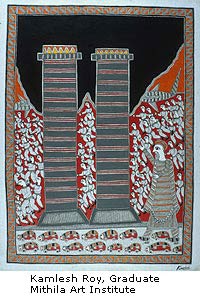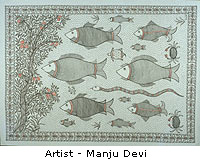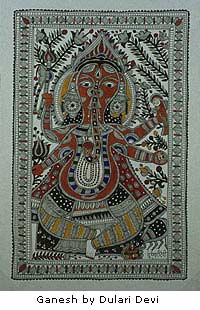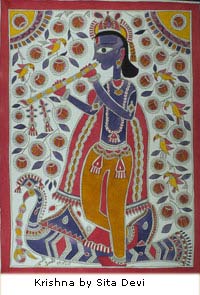
The Ethnic Arts Foundation and The Mithila Art Institute
NGOs
E: [email protected], [email protected], [email protected]
W: www.mithilapainting.org
| The Mithila region of northern Bihar and southern Nepal, is an ancient seat of South Asian civilization. Maithil men have long been known as poets, priests, and scholars. For centuries Maithil women have done elaborate wall and floor paintings for their life cycle and domestic rituals. In the late 1960s women of two castes began painting on paper for sale. Since then, Mithila Painting (at times called Madhubani painting as painting on paper began in the villages near Madhubani town), has expanded dramatically. Today, women of many castes are painting, styles and subjects have proliferated, some men are also painting, and artists of international stature have emerged. Despite these changes Mithila Painting remains highly distinctive, rooted in its ancient aesthetic traditions. | |
 |
|
| The Ethnic Arts Foundation (EAF) is a non-profit organization founded in 1980. It is dedicated to encouraging national and international appreciation of Mithila Painting and the continuing development of this vibrant indigenous aesthetic tradition. Over the years it has purchased some 1,200 paintings from over 150 artists, and has organized numerous exhibitions and sales in the USA, South Africa, Iceland, and India. Having some sold some 600 paintings to individuals, collectors, and museums it returns the profits directly to the artists to encourage them to continue doing their finest work. It also supported the publication of “Mithila Painting: the Evolution of an Art Form” by David Szanton and Malini Bakshi. In 2003 ithe EAF founded the free Mithila Art Institute in Madhubani to help train the next generation of Mithila painters. Its website: www.mithilapainting.org includes many paintings and additional information about the tradition. |  |
 |
The Mithila Art Institute The Mithila Art Institute (MAI) was established in Madhubani in January 2003 to encourage the development of a new generation of artists. 25 competitively selected and highly talented students (21 women and 4 men – from 18 to 25 years old), began a one-year course under the direction of Santosh Kumar Das, a major contemporary Mithila painter with a BFA from India’s leading art school in Baroda. Since then, every year, 20 to 25 new students are selected, and the six to eight ot the most talented continue for a second year of advanced training. Students who must travel from distant communities and second year students receive modest scholarships. |
| Eminent painters, Shashikala Devi and Manju Devi, are now co-directing the MAI assisted by other leading painters, an Advisory Board of local artists and scholars, and EAF staff, Prof. Elder, and Drs. Jha and Szanton. The MAI provides free instruction, working space, materials, and a supportive community for the young artists. The major emphases are strengthening their skills, imaginations, and roots in Mithila culture and aesthetics. |  |
 |
At the same time, students are encouraged to explore the possibilities of the tradition for depicting new subjects based on their own experience or current issues. Students are also introduced to other Indian traditions and the arts and visiting artists from other parts of the world. Their paintings are often unique and stunningly beautiful. Many are now in museums, universities, and private collections in India, the USA, Japan, and Europe. |
| The Evolution of Mithila Painting In 1934, a terrible earthquake revealed to W. G. Archer, a colonial official in Madhubani, the paintings on the interior walls of local village homes. Entranced by their beauty he and his wife wrote about them in several publications. In the 1950s and 1960s Indian artists and scholars visited Mithila and were equally struck by the paintings. Then in 1966, during a severe drought, the All India Handicrafts Board sent a Bombay artist, Baskar Kulkarni, to Madhubani to encourage the women to transfer their ritual wall paintings to paper and sell them as a new source of family income. |
 |
| Women of several castes painted, but only a small group of Mahapatra Brahmin and Kayastha (scribe) women agreed to paint on the hand-made paper Kulkarni provided. However, by the early 1970s, two of the women, Sita Devi and Ganga Devi, were recognized as superb artists and were sent to Europe, Japan, Russia, and the USA to represent India in major cultural expositions. Their successes encouraged scores of other women to paint on paper. Since then a few men and many women from other castes – especially the Dusadh, a Dalit community – have taken up painting and have won state and national awards as major artists. .
Aside from the growing diversity of people painting, the subjects of the paintings have also expanded from divinities and auspicious marriage icons to include ancient epics; local legends and tales; domestic and community life and ritual; the painters’ own life histories; and local, national, and international events and issues. Artists from different castes and genders are borrowing themes and styles from one another. Mithila Painting has shown an extraordinary vitality and become a vibrant and versatile aesthetically powerful tradition – simultaneously ancient and modern. With the growth of painting on paper for sale, women began earning substantial incomes that they use to send daughters to school and for better food and clothing, for their families. For many it has been a deeply empowering experience. |